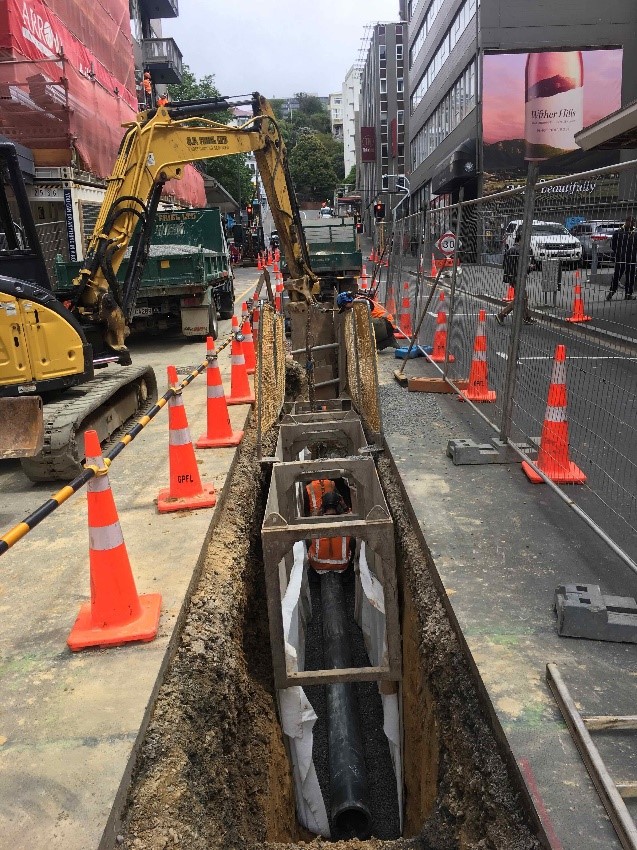|
Customer/Principal:
|
Brian Perry Civil/Wellington Water
|
|
Consultant:
|
GHD
|
|
Date:
|
Jun 2018 – Dec 2018
|
|
Capability:
|
Mobile Plant Fleet, Underground Services, Traffic Management, PE Welding, Deep Trenches
|
|
Customer Type:
|
Government & Local Government
|
|
Scope:
|
Utility diversions to facilitate installation of the pump station
Approximately 180m of 250OD PE100 SDR11 rising main from the pump station, along the centreline of Dixon St to a connection on the trunk sewer to the west of the Willis St intersection.
Gravity connections from the existing system in Dixon St and across Victoria St.
|

GPFL were engaged by BPC as a subcontractor to deliver all the underground pipework associated with the new pumping station. We believe that by developing lasting relationships with our customers we can deliver value. Our work with BPC on the Dixon St Pump Station is another example of how strong relationships can add to the success of a project.
During the project we successfully delivered a robust PE Weld testing regime on both butt fusion and electrofusion welds, dealt well with the discovery of abandoned asbestos ducts and pipes that clashed with the pipeline and produced some bespoke, designed shoring solutions to suit complex excavations of over 3m deep.
The work was completed safely and efficiently with GPFL offering a turnkey solution to BPC. Some key aspects of the delivery were the investigation work undertaken to make an outfall connection, the approach to Traffic Management and a Directional Drilled solution that delivered risk mitigations for both traffic Management and Underground Services.
Investigation of the Outfall Connection - As with any underground infrastructure scheme there was significant risk around unknown features or obstructions in the ground that would require the contractor and consultant to be agile and deliver design solutions that would keep the resources moving on site.
This was most apparent on the upstream connection of the rising main where GPFL and BPC undertook investigation work to finalise the design. Poor records in this location meant that the existing arrangement of the trunk sewer network was significantly different than anticipated. GPFL and BPC worked closely with GHD to deliver a new connection solution without any impact on the final programme. The final solution has health and safety advantages over the original proposal in terms of its delivery on site and the way the asset will be maintained in the future.
Traffic Management was critical to successful delivery of the project. BPC engaged GPFL to manage this aspect of the scheme directly for both the underground pipework scope and the main pump station.
GPFL approached the Road Controlling Authority prior to the project starting and negotiated with them to secure permanent lane closures on Dixon St and Victoria St to facilitate construction. We used Mooven flow monitoring software (championed by GHD and WWL) to provide real time data to the site team and the RCA. That data was used to test our assumptions about disruption and manage traffic flow during the work.
We worked with the resilience team in Wellington City Council to ensure that our traffic management arrangements were compatible with and, and where possible, added value to other ongoing construction projects in the area. Taking a “whole of city approach” provided a good outcome for the project and the RCA.
The traffic management design and delivery provided a safe and productive environment in which the work could be completed. By recognising that our project was part of a wider programme of works being delivered by the City we were able to work with the RCA and deliver benefits across the whole affected area.
Directional Drilling - Management of the risks around underground services is an important aspect of this type of work and in the Wellington CBD environment this can be especially challenging. The team on site were well trained and had a good understanding of our “before you dig” procedures. They were able to deliver the work with no significant incidents.
One of the high risk areas on the project from an underground services perspective was the Willis St intersection. The new rising main needed to cross this busy street and safely deal with the congested underground infrastructure. BPC and GPFL engaged a GPR specialist to help us understand the problem and then undertook a series of potholes to identify a possible route for the new main. We found significant differences from the information on records – including much deeper banks of cables that had not been anticipated in the original design.
BPC and GPFL looked at the risk profile around underground services and traffic management and proposed a directional drilled solution that could minimise the risk in both areas. BPC and GPFL completed all enabling works and then engaged Tier One to complete a successful drill shot. Out of the box thinking like this can turn a difficult challenge into a real success story.
There was significant design change during the work due to a clash of grades between the proposed alignment and existing services. The project team collaborated well with the consultant and customer to keep the project moving and offered value engineering options that addressed budget concerns. The final product is of a high quality and was delivered within the overall programme timeframe. Our work on this project contributed to the project being recognised with an award by CCNZ in 2019.
 |
Working under TM in a busy CBD environment
|
 |
Directional Drilling under Willis St
|
 |
Installation of deep gravity connections
|
 |
Finishing to a high standard
|
 |
Installation of deep gravity connections to the pump station
|
 |
Edge protection and shoring arrangements to a high standard
|